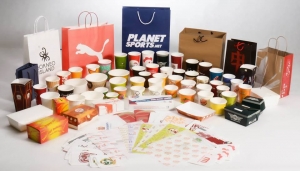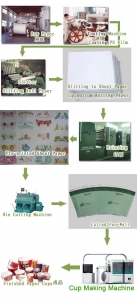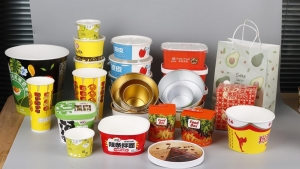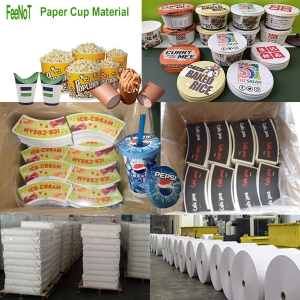What is paper cup? Bio compostable disposable eco paper cups,
A paper cup is a disposable container made from paperboard, designed to hold and serve both hot and cold beverages.
Following information copy from the internet.
What is paper cup?
A paper cup is a disposable container made from paperboard, designed to hold and serve both hot and cold beverages.
To make them liquid-proof, the paper is coated on the inside with a waterproofing material, such as a thin layer of plastic (polyethylene) or wax.
They are widely used for takeout services in coffee shops and restaurants, at offices, and during parties and events.
Construction and features
Insulation: Some paper cups have double or ripple walls to provide better insulation. This keeps hot drinks warm and protects hands from the heat.
Coating: The inner lining prevents the cup from getting soggy. Historically, this was wax, but many modern cups use polyethylene (PE) or, for more eco-friendly options, polylactic acid (PLA). Newer, plastic-free coatings are also being developed to improve recyclability.
Lids: Paper cups for hot beverages often come with plastic lids to prevent spills and keep the drink hot. These lids are designed with a small opening for sipping.
Customization: Brands can print logos and designs on the paper cups for marketing purposes.
History
Ancient use: Paper cups, known as chih pei, have existed since 2nd-century imperial China and were used for serving tea.
Modern development: The modern, disposable paper cup was popularized in the early 20th century in the United States.
Public health concerns: The shift from communal glasses to disposable cups was driven by public health campaigns, which highlighted the spread of germs from shared drinking vessels in public places.
Dixie Cup: One of the most famous early brands was the “Health Kup,” later renamed the “Dixie Cup,” which was developed by Lawrence Luellen and Hugh Moore to be used with a water-vending machine.
Environmental impact and recycling
Challenges: The plastic lining in many paper cups makes them difficult to recycle in standard paper recycling facilities, and they often end up in landfills.
Newer solutions: Some manufacturers are addressing this issue by using more easily recyclable coatings, or by creating paper cups that are fully biodegradable or compostable under the right conditions.
Environmental tradeoffs: Compared to reusable containers, disposable paper cups still use significant energy and resources for manufacturing and contribute to waste. However, they are often considered a more environmentally friendly option than disposable plastic or foam cups.
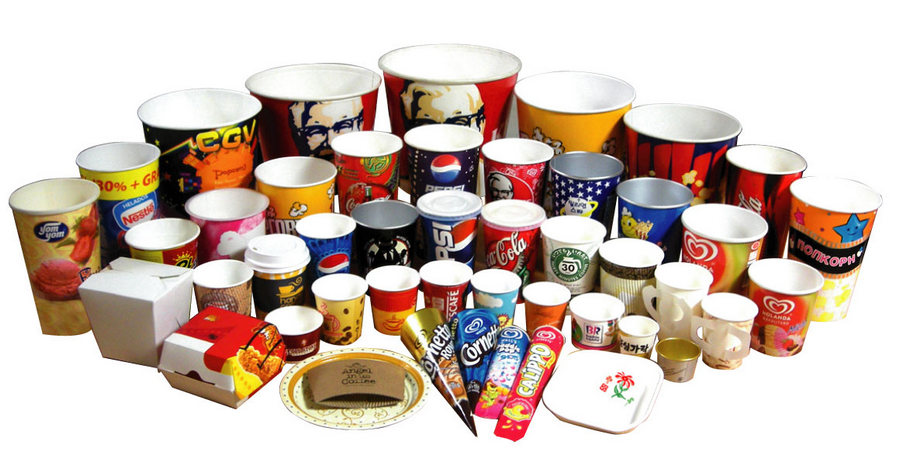
What is paper cup Disposable paper cup information history
What is paper cup?
Popularly, the disposable cups made by Servo paper cup machine, called paper cups.
A paper cup is a small, disposable cup made from paper, often coated with plastic or wax to prevent liquids from leaking.
Popular for single-use applications due to their lightweight and inexpensive nature.
Here’s a more detailed breakdown:
- Material: Primarily made from paper, with a lining of plastic or wax to make it waterproof.
- Purpose: Designed to hold beverages, both hot and cold.
- Disposable: Intended for single use and then disposal.
- Advantages: Lightweight, inexpensive, and easily recyclable.
- Alternatives: Other disposable cup materials include plastic, polystyrene, and foam.
- Environmental Impact: While biodegradable and compostable under the right conditions, paper cups often have a plastic lining that can complicate recycling.
What is paper cup? Bio compostable disposable eco paper cups
Following information copy from Wikipedia.
A paper cup is a disposable cup made out of paper and often lined or coated with plastic or wax to prevent liquid from leaking out or soaking through the paper.
Disposable cups in shared environments have become more common for hygienic reasons after the advent of the germ theory of disease.
Due mainly to environmental concerns, modern disposable cups may be made of recycled paper or other inexpensive materials such as plastic.
History of Paper cup
Paper cups have been documented in imperial China, where paper was invented by the 2nd century BC.
The paper cups were known as chih pei and were used for the serving of tea.
They were constructed in different sizes and colors, and were adorned with decorative designs.
Textual evidence of paper cups appears in a description of the possessions of the Yu family, from the city of Hangzhou.
The modern paper cup was developed in the 20th century. In the early 20th century, it was common to have shared glasses or dippers at water sources such as school faucets or water barrels in trains.
This shared use caused public health concerns.
Histories
One notable investigation into their use was the study by Alvin Davison, biology professor at Lafayette College, published with the sensational title “Death in School Drinking Cups” in Technical World Magazine in August 1908, based on research carried out in Easton, Pennsylvania’s public schools.
The article was reprinted and distributed by the Massachusetts State Board of Health in November 1909.
Based on these concerns, and as paper goods (especially after the 1908 invention of the Dixie Cup) became cheaply and cleanly available, local bans were passed on the shared-use cup.
One of the first railway companies to use disposable paper cups was the Lackawanna Railroad, which began using them in 1909. By 1917, the public glass had disappeared from railway carriages, replaced by paper cups even in jurisdictions where public glasses had yet to be banned.
Paper cups are also employed in hospitals for health reasons. In 1942 the Massachusetts State College found in one study that the cost of using washable glasses, re-used after being sanitized, was 1.6 times the cost of using single-service paper cups.
These studies, as well as the reduction in the risk of cross-infection, encouraged the use of paper cups in hospitals.
Manufacture
The base paper for paper cups is called “cup board”, and is made on special multi-ply paper machines. It has a barrier coating for waterproofing.
The paper needs high stiffness and strong wet sizing. The cup board grade has a special design for the cup manufacturing processes.
The mouth roll forming process requires good elongation properties of the board and the plastic coating.
A well formed mouth roll provides stiffness and handling properties in the cup. The basis weights of the cup boards are 170–350 g/m2.
To meet hygiene requirements, paper cups are generally manufactured from virgin (non-recycled) materials.
The one exception to this is when the paper cup features an extra insulating layer for heat retention, which never comes into contact with the beverage, such as a corrugated layer wrapped around a single-wall cup.
Waterproofing
Originally, paper cups for hot drinks were glued together and made waterproof by dropping a small amount of clay in the bottom of the cup, and then spinning at high speed so that clay would travel up the walls of the cup, making the paper water-resistant.
However, this resulted in drinks smelling and tasting of cardboard.
Cups for cold drinks could not be treated in the same way, as condensation forms on the outside, then soaks into the board, making the cup unstable.
To remedy this, cup manufacturers developed the technique of spraying both the inside and outside of the cup with wax.
Clay and wax-coated cups disappeared with the invention of polyethylene (PE)-coated cups;
this process covers the surface of the board with a very thin layer of PE, waterproofing the board and welding the seams together.
In 2017, the Finnish board manufacturer Kotkamills launched a new kind of cup (food service) board which uses no wax or plastic for waterproofing,
and thus can be recycled as part of the normal paper and board waste stream, biodegraded, or even composted in small quantities.
In 2017, the Newport Beach, California, company Smart Planet Technologies, launched “reCUP” for the UK market, a recyclable paper cup using a polyethylene and mineral-blended coating branded EarthCoating, that is engineered to be recycled through traditional paper recycling systems.
Paper cups with EarthCoating are sold by Detpak, Huhtamaki, Linstol, and Pureco USA.
Printing on paper cups
1, Flexo printing:
Originally paper cups were printed using rubber blocks mounted on cylinders, with a different cylinder for each colour.
Registration across different colours was very difficult, but later flexography plates became available and with the use of mounting systems it became easier to register across the colours, allowing for more complex designs. Printing flexographic has become ideal for long runs and manufacturers generally use this method when producing over a million cups.
Machines such as Comexi are used for this, which have been adapted to take the extra large reels that are required by paper cup manufacturers.
Ink technology has also changed and where solvent-based inks were being used, water-based inks are instead being utilised.
One of the side effects of solvent-based inks is that hot drink cups in particular can smell of solvent, whereas water-based inks have eliminated this problem.
2, Offset printing:
Other methods of printing have been used for short runs such as offset printing, which can vary within a range from 10,000 to 100,000 cups.
Offset printing inks have also been developed and although in the past these were solvent based, the latest soya-based inks have reduced the danger of cups smelling.
3, Digital printing:
The latest development is Direct-printing, which allows printing on very small quantities, typically from 1,000 cups, and is used by companies including Brendos Ltd offering small quantities in short lead times.
4, Rotogravure printing:
Rotogravure can also be used, but this is extremely expensive and is normally only utilised for items requiring extremely high quality printing like ice cream containers.
Plastic material:
Polyethylene (PE) is a petroleum-based coating on paper cups that can slow down the process of biodegrading of the paper it coats.
Polylactic acid (PLA) is a biodegradable bio-plastic coating used on some paper cups.
PLA is a renewable resource and is certified compostable in industrial composting facilities,
which means that when it biodegrades, it does not leave behind any toxic residues.
Although PLA-lined cups are the only paper cups which can be composted fully,
they can contaminate the waste stream, reportedly making other recycled plastics unsaleable.
Lids
Paper cups may have various types of lids.
The yogurt paper cups containers, for example, generally have two types of lids: heat-seal foil lids used for small “single serving” containers, and 150–200 ml (5–7 US fl oz) plastic press-on, resealable lids used for large “family size” containers, 250–1,000 ml (8–30 US fl oz), where not all of the yogurt may be consumed at any one time and thus the ability to re-close the container is required.
Hot drinks sold in paper cups may come with a plastic lid, to keep the drink hot and prevent spillage.
These lids have a hole through which to sip the drinks.
The plastic lids can have many features including peel back tabs, raised walls to protect the foam of gourmet hot drinks and embossed text.
In 2008, Starbucks introduced shaped plastic “splash sticks” to block the hole, in some of their stores, after customer complaints about hot coffee splashing through it.
What is paper cup? Disposable paper cup information history
 Feenot paper cup machine
Feenot paper cup machine

